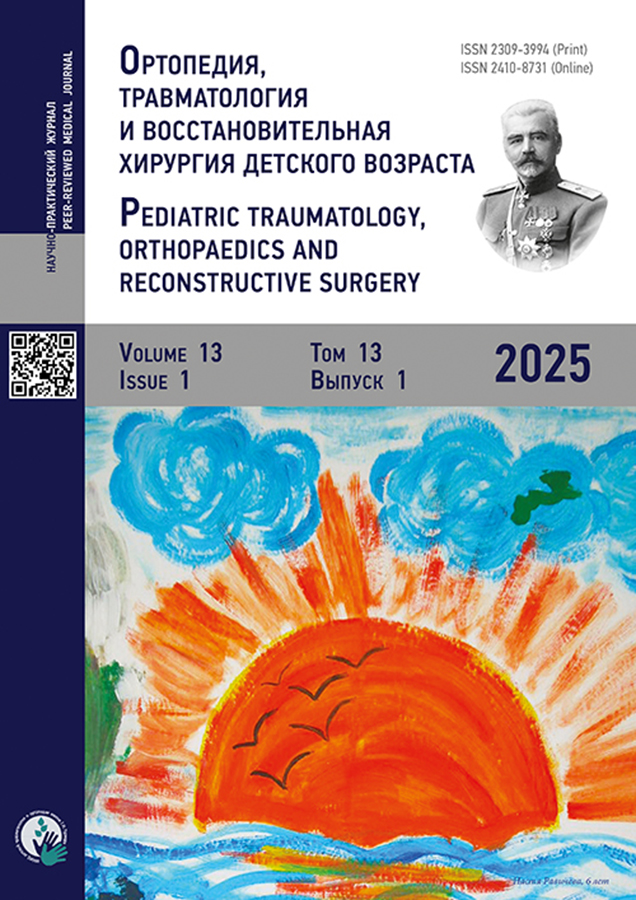Patient-specific 3D template with radiopaque markers for pediatric pedicle screw fixation: comparison with freehand technique
- Authors: Toria V.G.1, Vissarionov S.V.1, Kubanov R.R.1
-
Affiliations:
- H. Turner National Medical Research Center for Children’s Orthopedics and Trauma Surgery
- Issue: Vol 13, No 1 (2025)
- Pages: 62-69
- Section: New technologies in trauma and orthopedic surgery
- Submitted: 19.01.2025
- Accepted: 11.02.2025
- Published: 18.04.2025
- URL: https://journals.eco-vector.com/turner/article/view/646353
- DOI: https://doi.org/10.17816/PTORS646353
- EDN: https://elibrary.ru/FVENEK
- ID: 646353
Cite item
Abstract
BACKGROUND: Accuracy and precision are crucial in pedicle screw implantation in children with congenital spinal deformities combined with thoracic cage anomalies. The use of patient-specific navigation templates supplemented with radiopaque markers significantly improves screw positioning accuracy and reduces the risk of complications.
AIM: To evaluate the effectiveness of a novel patient-specific surgical template with radiopaque markers and accuracy of pedicle screw placement in children with congenital spinal deformities combined with thoracic cage anomalies, compared with the freehand technique.
METHODS: The study included 26 patients (aged 4–9 years) who underwent surgery at a specialized center. The patients were grouped into two: group 1 (n = 13) underwent screw placement using the new template with radiopaque markers and group 2 (n = 13) underwent screw placement using the freehand technique. Screw placement accuracy was evaluated using the Gertzbein scale based on postoperative radiographs and computed tomography. Statistical analysis was performed using the Student’s t-test, with p < 0.05 indicating significance.
RESULTS: In the navigation template group, 100% of screws were placed correctly (grade 0). In the freehand group, 80.5% of screws were correctly positioned; 16.9% showed deviations up to 2 mm (grade 1), and 2.6% showed deviations >2 mm (grade 2). The use of the navigation template significantly reduced the time required for bone canal preparation compared with the freehand method.
CONCLUSION: Navigation templates with radiopaque markers demonstrate high accuracy and correctness in pedicle screw placement in children with congenital spinal deformities, reducing malposition risk and shortening operative time. Their widespread implementation may enhance the safety and effectiveness of surgical treatment in this patient population.
Full Text
About the authors
Vakhtang G. Toria
H. Turner National Medical Research Center for Children’s Orthopedics and Trauma Surgery
Author for correspondence.
Email: vakdiss@yandex.ru
ORCID iD: 0000-0002-2056-9726
SPIN-code: 1797-5031
MD
Russian Federation, Saint PetersburgSergei V. Vissarionov
H. Turner National Medical Research Center for Children’s Orthopedics and Trauma Surgery
Email: vissarionovs@gmail.com
ORCID iD: 0000-0003-4235-5048
SPIN-code: 7125-4930
MD, PhD, Dr. Sci. (Medicine), Professor, Corresponding Member of RAS
Russian Federation, Saint PetersburgRamil R. Kubanov
H. Turner National Medical Research Center for Children’s Orthopedics and Trauma Surgery
Email: Kubrrash@outlook.com
ORCID iD: 0009-0003-3937-3621
SPIN-code: 5825-3395
MD
Russian Federation, Saint PetersburgReferences
- Mackel CE, Jada A, Samdani AF, et al. A comprehensive review of the diagnosis and management of congenital scoliosis. Childs Nerv Syst. 2018;34(11):2155–2171. EDN: ZIWCEZ doi: 10.1007/s00381-018-3915-6
- Blevins K, Battenberg A, Beck A. Management of Scoliosis. Adv Pediatr. 2018;65(1):249–266. doi: 10.1016/j.yapd.2018.04.013
- Huh S, Eun LY, Kim NK, et al. Cardiopulmonary function and scoliosis severity in idiopathic scoliosis children. Korean J Pediatr. 2015;58(6):218–223. doi: 10.3345/kjp.2015.58.6.218
- Burnei G, Gavriliu S, Vlad C, et al. Congenital scoliosis: an up-to-date. J Med Life. 2015;8(3):388–397.
- Ruf M. Operative Surgical treatment of congenital scoliosis. Oper Orthop Traumatol. 2024;36(1):4–11. EDN: KPITWC doi: 10.1007/s00064-023-00827-5
- Pahys JM, Guille JT. What’s new in congenital scoliosis? J Pediatr Orthop. 2018;38(3):e172–e179. doi: 10.1097/BPO.0000000000000922
- Cao J, Zhang X, Liu H, et al. 3D printed templates improve the accuracy and safety of pedicle screw placement in the treatment of pediatric congenital scoliosis. BMC Musculoskelet Disord. 2021;22(1):1014. EDN: NZIIZA doi: 10.1186/s12891-021-04892-4
- Toriya VG, Vissarionov SV, Pershina PА. Evaluation of the efficacy of a novel customized guide with visual control function in children with congenital spinal deformity. Pediatric Traumatology, Orthopaedics and Reconstructive Surgery. 2024;12(4):473–480. doi: 10.17816/PTORS641742
- Toriya VG, Vissarionov SV, Manukovskiy VA, Pershina PA. Advantages of using template guides in children for the correction of congenital spinal deformities and thoracic anomalies. Pediatric Traumatology, Orthopaedics and Reconstructive Surgery. 2024;12(2):217–223. EDN: CPUTOA doi: 10.17816/PTORS632132
- Fujita R, Oda I, Takeuchi H, et al. Accuracy of pedicle screw placement using patient-specific template guide system. J Orthop Sci. 2022;27(2):348–354. EDN: ISNFZV doi: 10.1016/j.jos.2021.01.007
- Mahmoud A, Shanmuganathan K, Rocos B, et al. Cervical spine pedicle screw accuracy in fluoroscopic, navigated and template guided systems – a systematic review. Tomography. 2021;7(4):614–622. EDN: VPDLRP doi: 10.3390/tomography7040052
- Liang W, Han B, Hai JJ, et al. 3D-printed drill guide template, a promising tool to improve pedicle screw placement accuracy in spinal deformity surgery: a systematic review and meta-analysis. Eur Spine J. 2021;30(5):1173–1183. EDN: UUFLPK doi: 10.1007/s00586-021-06739-x
Supplementary files












